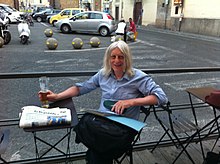String field theory (SFT) is a formalism in string theory in which the dynamics of relativistic strings is reformulated in the language of quantum field theory. This is accomplished at the level of perturbation theory by finding a collection of vertices for joining and splitting strings, as well as string propagators, that give a Feynman diagram-like expansion for string scattering amplitudes. In most string field theories, this expansion is encoded by a classical action found by second-quantizing the free string and adding interaction terms. As is usually the case in second quantization, a classical field configuration of the second-quantized theory is given by a wave function in the original theory. In the case of string field theory, this implies that a classical configuration, usually called the string field, is given by an element of the free string Fock space.

Gerardus (Gerard) 't Hooft is a Dutch theoretical physicist and professor at Utrecht University, the Netherlands. He shared the 1999 Nobel Prize in Physics with his thesis advisor Martinus J. G. Veltman "for elucidating the quantum structure of electroweak interactions".

Nathan "Nati" Seiberg is an Israeli American theoretical physicist who works on quantum field theory and string theory. He is currently a professor at the Institute for Advanced Study in Princeton, New Jersey, United States.
A conformal anomaly, scale anomaly, trace anomaly or Weyl anomaly is an anomaly, i.e. a quantum phenomenon that breaks the conformal symmetry of the classical theory.
Montonen–Olive duality or electric–magnetic duality is the oldest known example of strong–weak duality or S-duality according to current terminology. It generalizes the electro-magnetic symmetry of Maxwell's equations by stating that magnetic monopoles, which are usually viewed as emergent quasiparticles that are "composite", can in fact be viewed as "elementary" quantized particles with electrons playing the reverse role of "composite" topological solitons; the viewpoints are equivalent and the situation dependent on the duality. It was later proven to hold true when dealing with a N = 4 supersymmetric Yang–Mills theory. It is named after Finnish physicist Claus Montonen and British physicist David Olive after they proposed the idea in their academic paper Magnetic monopoles as gauge particles? where they state:
There should be two "dual equivalent" field formulations of the same theory in which electric (Noether) and magnetic (topological) quantum numbers exchange roles.
Emil John Martinec is an American string theorist, a physics professor at the Enrico Fermi Institute at the University of Chicago, and director of the Kadanoff Center for Theoretical Physics. He was part of a group at Princeton University that developed heterotic string theory in 1985.
In theoretical physics, boundary conformal field theory (BCFT) is a conformal field theory defined on a spacetime with a boundary. Different kinds of boundary conditions for the fields may be imposed on the fundamental fields; for example, Neumann boundary condition or Dirichlet boundary condition is acceptable for free bosonic fields. BCFT was developed by John Cardy.
Igor R. Klebanov is an American theoretical physicist. Since 1989, he has been a faculty member at Princeton University where he is currently a Eugene Higgins Professor of Physics and the director of the Princeton Center for Theoretical Science. In 2016, he was elected to the National Academy of Sciences. Since 2022, he is the director of the Simons Collaboration on Confinement and QCD Strings.
Bruno Zumino was an Italian theoretical physicist and faculty member at the University of California, Berkeley. He obtained his DSc degree from the University of Rome in 1945.
In quantum field theory the C-theorem states that there exists a positive real function, , depending on the coupling constants of the quantum field theory considered, , and on the energy scale, , which has the following properties:
In theoretical physics, a logarithmic conformal field theory is a conformal field theory in which the correlators of the basic fields are allowed to be logarithmic at short distance, instead of being powers of the fields' distance. Equivalently, the dilation operator is not diagonalizable.

Sunil Mukhi is an Indian theoretical physicist working in the areas of string theory, quantum field theory and particle physics. Currently he is Adjunct Professor at the International Centre for Theoretical Sciences of the Tata Institute of Fundamental Research and Honorary Professor Emeritus at the Indian Institute of Science Education and Research, Pune.
Warren Siegel is a theoretical physicist specializing in supersymmetric quantum field theory and string theory. He was a professor at the C. N. Yang Institute for Theoretical Physics at Stony Brook University. He retired in Fall of 2022.
David B. Fairlie is a British mathematician and theoretical physicist, Professor Emeritus at the University of Durham (UK).

Werner Nahm is a German theoretical physicist. He has made contributions to mathematical physics and fundamental theoretical physics.

Augusto Sagnotti is an Italian theoretical physicist at Scuola Normale.
Luis Álvarez-Gaumé is a Spanish theoretical physicist who works on string theory and quantum gravity.
Peter Christopher West, born on 4 December 1951, is a British theoretical physicist at King's College, London and a fellow of the Royal Society.
Martin B. Einhorn is an American theoretical physicist.
Zohar Komargodski is an Israeli theoretical physicist who works on quantum field theory, including conformal field theories, gauge theories and supersymmetry.





